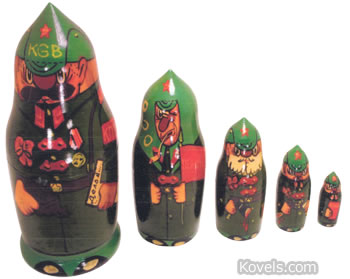Q: I have a set of Russian nesting dolls I was told were made by or for the former KGB. The dolls are dressed in similar Soviet uniforms, but there are lists of different things on the back of each doll. The largest doll is marked with the words “Communism” and “Genocide” and a list that includes Poland, Korea, and other communist countries. The next doll lists people who could have been a threat to the KGB (Tito, Kutepov, and S. Bandera). The third has a list of different types of crimes (murders, kidnaps, etc.), and the last a list that appears to be related to Soviet Gulag forced-labor camps. The smallest doll has no list. Can you tell me anything about them?
A: Nesting dolls were first made in Russia in about 1890. They are called “matryoshka dolls” or “babushka dolls.” Vintage matryoshka dolls were made with different costumes and decorations, depending on the region where they were made. Many modern versions have also been made. Political themes became popular after the dissolution of the Soviet Union in 1991. Especially popular were nesting dolls representing well-known political leaders from the 1950s and later. Your brightly colored set is unusual because it mentions many historic and political places and events. Unusual dolls like yours might sell for about $150 at a doll auction or an auction of political items.




I would adore owning something like this! I’m familiar with the dolls but this particular set sounds wonderful, and I wish we could see the backs as well. Thanks for sharing them.